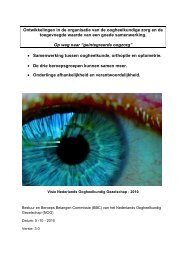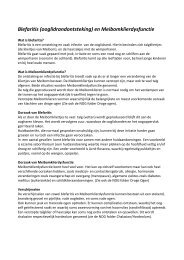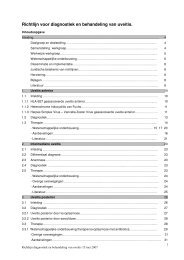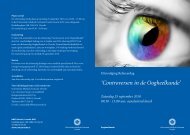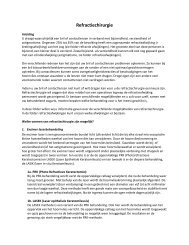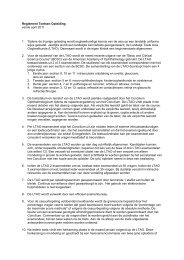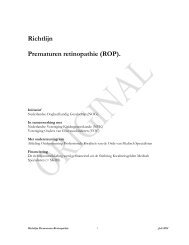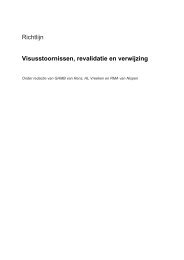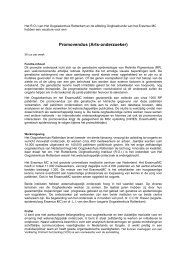terminology and guidelines for glaucoma ii - Kwaliteitskoepel
terminology and guidelines for glaucoma ii - Kwaliteitskoepel
terminology and guidelines for glaucoma ii - Kwaliteitskoepel
Create successful ePaper yourself
Turn your PDF publications into a flip-book with our unique Google optimized e-Paper software.
) Plateau-iris mechanism<br />
The isolated plateau iris mechanism causes angle-closure by direct obliteration of the chamber angle recess, crowded<br />
by the iris base when the pupil is dilated. This can occur only with one or more of the following:<br />
(1) the tissue of the peripheral iris is thick (iris rolls)<br />
(2) the iris base inserts anteriorly, leaving only a very narrow ciliary b<strong>and</strong>, or inserts at the scleral spur<br />
(3) the ciliary processes are displaced anteriorly in the posterior chamber <strong>and</strong> push the iris base into the chamber<br />
angle.<br />
(4) the iris profile is almost flat from the perifery to the far periphery, where it becomes very steep, creating an extremely<br />
narrow angle recess.<br />
The iris root position <strong>and</strong> the posterior chamber anatomy can be confirmed by ultrasound biomicroscopy.<br />
It is clear from these descriptions why the isolated plateau iris mechanism is not altered by iridectomy.<br />
The pure plateau iris syndrome, causing angle-closure despite a patent iridotomy, is extremely rare compared with<br />
pupillary block. Both mechanisms, however, may coincide when “plateau iris configuration” is present. This latter<br />
condition is relatively common. The pure <strong>for</strong>m of plateau iris syndrome can only be proven by the occurrence of<br />
acute angle-closure triggered by mydriasis despite a patent iridectomy <strong>and</strong> a centrally deep anterior chamber.<br />
Due to the above mechanisms, in all combined pupillary block/plateau iris cases iridotomy or iridectomy should be<br />
per<strong>for</strong>med first. Plateau iris can be treated by argon laser iridoplasty <strong>and</strong>/or miotic therapy, preferably with topical<br />
sympatholytics like dapiprazole or thymoxamine. Strong miotics are to be avoided, because they cause anterior rotation<br />
of the ciliary body. Ideally, treatment should be instituted be<strong>for</strong>e synechial closure of the angle occurs (see Ch.<br />
4.4.1).<br />
c) Lens mechanism<br />
Large <strong>and</strong>/or anteriorly placed cristalline lens can predispose per se to angle-closure <strong>and</strong> be a factor in worsening<br />
pupillary block. It can also cause secondary angle-closure <strong>glaucoma</strong> (see Ch. 2.5.1 <strong>and</strong> 2.5.3.).<br />
d) Creeping angle-closure mechanism<br />
Some cases of chronic angle-closure <strong>glaucoma</strong> result from synechial closure of the chamber angle, caused by a previous<br />
acute angle-closure ‘attack’, while creeping angle-closure is probably a primary event. The iris base ‘creeps’ on<br />
to the trabecular meshwork <strong>for</strong>ming irreversible peripheral anterior synechiae (PAS). The IOP usually rises when<br />
more than half of the angle is obstructed. It is not yet clear whether creeping angle-closure is the consequence of<br />
undiagnosed intermittent angle-closure or a consequence of chronic miotic therapy causing worsening relative pupillary<br />
block. This <strong>for</strong>m seems to be more frequent in Asians.<br />
e) Posterior aqueous misdirection mechanism<br />
In rare cases posterior aqueous misdirection can be the cause of primary angle-closure, mostly resulting in chronic IOP<br />
elevation. In these cases, usually younger or middle aged women, the ciliary processes come into contact with the lens<br />
equator, <strong>and</strong>/or a firm zonule/posterior capsule diaphragm, causing misdirection of aqueous into the vitreous 8,9 . As a<br />
consequence, the lens/iris diaphragm is pushed <strong>for</strong>ward <strong>and</strong> occludes the chamber angle. Eyes predisposed to posterior<br />
aqueous misdirection often have narrow anterior chambers (peripheral <strong>and</strong> axial) <strong>and</strong> hypermetropia. After iridotomy<br />
or iridectomy, the use of miotics raises the IOP, whereas the use of cycloplegics reduces the IOP. This ‘inverse’ or ‘paradoxical’<br />
reaction to parasympathomimetics should be tested only after iridotomy has been per<strong>for</strong>med. Ultrasound biomicroscopy<br />
can demonstrate abnormal posterior chamber anatomy in these rare cases (see Ch. 2.5.3).<br />
Systemic drugs <strong>and</strong> angle-closure:<br />
Systemic drugs which may induce angle-closure in pre-disposed individuals are phenothiazines <strong>and</strong> their derivatives,<br />
tricyclic <strong>and</strong> non-tricyclic antidepressants, monoamine oxidase inhibitors, antihistamines, anti-Parkinson drugs, some<br />
minor tranquilizers, parasympatholytic <strong>and</strong> sympathomimetic agent (see Ch. 1.4).<br />
Ch. 2 - 14 EGS



